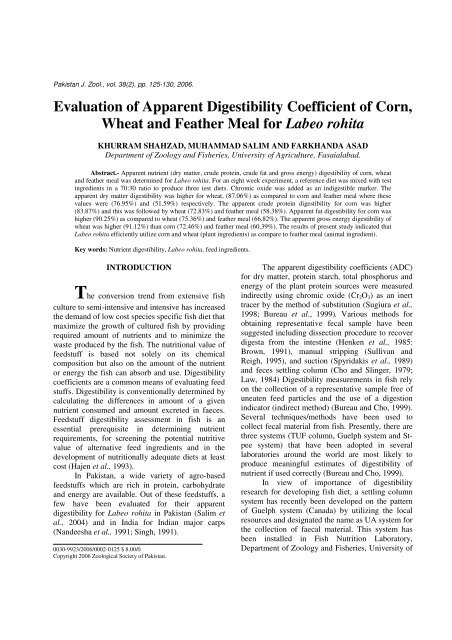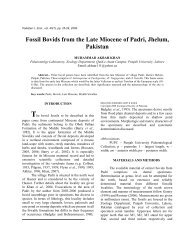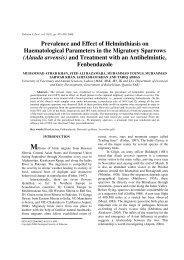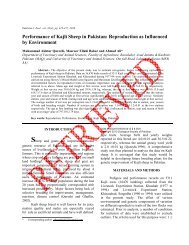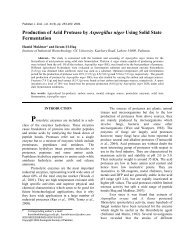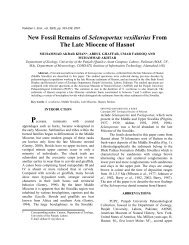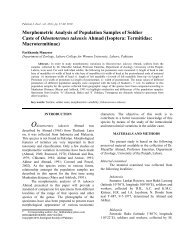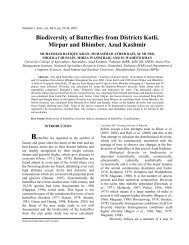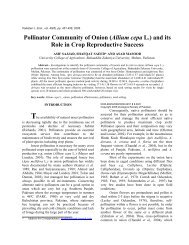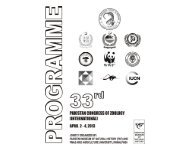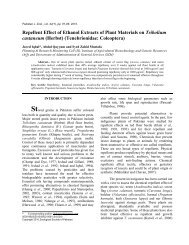Evaluation of Apparent Digestibility Coefficient of Corn ... - Zsp.com.pk
Evaluation of Apparent Digestibility Coefficient of Corn ... - Zsp.com.pk
Evaluation of Apparent Digestibility Coefficient of Corn ... - Zsp.com.pk
You also want an ePaper? Increase the reach of your titles
YUMPU automatically turns print PDFs into web optimized ePapers that Google loves.
Pakistan J. Zool., vol. 38(2), pp. 125-130, 2006.<br />
<strong>Evaluation</strong> <strong>of</strong> <strong>Apparent</strong> <strong>Digestibility</strong> <strong>Coefficient</strong> <strong>of</strong> <strong>Corn</strong>,<br />
Wheat and Feather Meal for Labeo rohita<br />
KHURRAM SHAHZAD, MUHAMMAD SALIM AND FARKHANDA ASAD<br />
Department <strong>of</strong> Zoology and Fisheries, University <strong>of</strong> Agriculture, Fasaialabad.<br />
Abstract.- <strong>Apparent</strong> nutrient (dry matter, crude protein, crude fat and gross energy) digestibility <strong>of</strong> corn, wheat<br />
and feather meal was determined for Labeo rohita. For an eight week experiment, a reference diet was mixed with test<br />
ingredients in a 70:30 ratio to produce three test diets. Chromic oxide was added as an indigestible marker. The<br />
apparent dry matter digestibility was higher for wheat, (87.06%) as <strong>com</strong>pared to corn and feather meal where these<br />
values were (76.95%) and (51.59%) respectively. The apparent crude protein digestibility for corn was higher<br />
(83.87%) and this was followed by wheat (72.83%) and feather meal (58.38%). <strong>Apparent</strong> fat digestibility for corn was<br />
higher (90.25%) as <strong>com</strong>pared to wheat (75.36%) and feather meal (66.82%). The apparent gross energy digestibility <strong>of</strong><br />
wheat was higher (91.12%) than corn (72.46%) and feather meal (60.39%). The results <strong>of</strong> present study indicated that<br />
Labeo rohita efficiently utilize corn and wheat (plant ingredients) as <strong>com</strong>pare to feather meal (animal ingredient).<br />
Key words: Nutrient digestibility, Labeo rohita, feed ingredients.<br />
INTRODUCTION<br />
The conversion trend from extensive fish<br />
culture to semi-intensive and intensive has increased<br />
the demand <strong>of</strong> low cost species specific fish diet that<br />
maximize the growth <strong>of</strong> cultured fish by providing<br />
required amount <strong>of</strong> nutrients and to minimize the<br />
waste produced by the fish. The nutritional value <strong>of</strong><br />
feedstuff is based not solely on its chemical<br />
<strong>com</strong>position but also on the amount <strong>of</strong> the nutrient<br />
or energy the fish can absorb and use. <strong>Digestibility</strong><br />
coefficients are a <strong>com</strong>mon means <strong>of</strong> evaluating feed<br />
stuffs. <strong>Digestibility</strong> is conventionally determined by<br />
calculating the differences in amount <strong>of</strong> a given<br />
nutrient consumed and amount excreted in faeces.<br />
Feedstuff digestibility assessment in fish is an<br />
essential prerequisite in determining nutrient<br />
requirements, for screening the potential nutritive<br />
value <strong>of</strong> alternative feed ingredients and in the<br />
development <strong>of</strong> nutritionally adequate diets at least<br />
cost (Hajen et al., 1993).<br />
In Pakistan, a wide variety <strong>of</strong> agro-based<br />
feedstuffs which are rich in protein, carbohydrate<br />
and energy are available. Out <strong>of</strong> these feedstuffs, a<br />
few have been evaluated for their apparent<br />
digestibility for Labeo rohita in Pakistan (Salim et<br />
al., 2004) and in India for Indian major carps<br />
(Nandeesha et al., 1991; Singh, 1991).<br />
0030-9923/2006/0002-0125 $ 8.00/0<br />
Copyright 2006 Zoological Society <strong>of</strong> Pakistan.<br />
The apparent digestibility coefficients (ADC)<br />
for dry matter, protein starch, total phosphorus and<br />
energy <strong>of</strong> the plant protein sources were measured<br />
indirectly using chromic oxide (Cr2O3) as an inert<br />
tracer by the method <strong>of</strong> substitution (Sugiura et al.,<br />
1998; Bureau et al., 1999). Various methods for<br />
obtaining representative fecal sample have been<br />
suggested including dissection procedure to recover<br />
digesta from the intestine (Henken et al., 1985:<br />
Brown, 1991), manual stripping (Sullivan and<br />
Reigh, 1995), and suction (Spyridakis et al., 1989)<br />
and feces settling column (Cho and Slinger, 1979;<br />
Law, 1984) <strong>Digestibility</strong> measurements in fish rely<br />
on the collection <strong>of</strong> a representative sample free <strong>of</strong><br />
uneaten feed particles and the use <strong>of</strong> a digestion<br />
indicator (indirect method) (Bureau and Cho, 1999).<br />
Several techniques/methods have been used to<br />
collect fecal material from fish. Presently, there are<br />
three systems (TUF column, Guelph system and Stpee<br />
system) that have been adopted in several<br />
laboratories around the world are most likely to<br />
produce meaningful estimates <strong>of</strong> digestibility <strong>of</strong><br />
nutrient if used correctly (Bureau and Cho, 1999).<br />
In view <strong>of</strong> importance <strong>of</strong> digestibility<br />
research for developing fish diet, a settling column<br />
system has recently been developed on the pattern<br />
<strong>of</strong> Guelph system (Canada) by utilizing the local<br />
resources and designated the name as UA system for<br />
the collection <strong>of</strong> faecal material. This system has<br />
been installed in Fish Nutrition Laboratory,<br />
Department <strong>of</strong> Zoology and Fisheries, University <strong>of</strong>
126<br />
Agriculture, Faisalabad, for carrying out apparent<br />
digestibility experiments. Presently, major carps are<br />
cultured under semi intensive system and are fed<br />
supplemental diets, formulated on an impirical<br />
formula by using conventional feedstuffs. Due to<br />
low fish production, there is increasing demand for<br />
the development <strong>of</strong> low cost, balanced diet for<br />
major carps. It is assumed that the knowledge <strong>of</strong><br />
digestibility <strong>of</strong> feedstuffs is essential for the<br />
formulation <strong>of</strong> fish diet. Recently, efforts were made<br />
to screen out digestibility <strong>of</strong> a few locally available<br />
feedstuffs for major carps by using UA system but<br />
there is a need to explore the digestibility <strong>of</strong> all the<br />
<strong>com</strong>mercially available feedstuffs.<br />
The present study was designed to evaluate<br />
the nutritive value <strong>of</strong> feedstuffs (corn, wheat and<br />
<strong>com</strong>mercially available feather meal) through<br />
digestibility experiment for Labeo rohita<br />
fingerlings, using chromic oxide (Cr2O3) as<br />
indigestible marker.<br />
MATERIALS AND METHODS<br />
The present study was carried out for the<br />
evaluation <strong>of</strong> ADC <strong>of</strong> corn, wheat and feather meal<br />
for Labeo rohita. The experiment was conducted<br />
from 1 st July to 31st August, 2005 in the Fish<br />
Nutrition Laboratory <strong>of</strong> the Department.<br />
Experimental fish<br />
Labeo rohita, fingerlings (average weight<br />
16.00±0.54 g) were purchased from the Government<br />
Fish Seed Hatchery, Satiana Road, Faisalabad. The<br />
fingerlings were acclimatized for one week in glass<br />
aquaria (2.4 x 1.3 x 0.9m). During this period fish<br />
were fed once daily to apparent satiation on the<br />
reference diet used in subsequent digestibility study<br />
(Allan and Rowland, 1992). Before the start <strong>of</strong><br />
experiment, fish were treated with 5g/l NaCl to<br />
ensure fish were free <strong>of</strong> ectoparasites and to prevent<br />
fungal infection (Rowland and Ingram, 1991).<br />
Feed ingredient and diet preparation<br />
Each test diet was <strong>com</strong>posed <strong>of</strong> 70 percent<br />
reference diet and 30 percent test ingredient (corn,<br />
wheat and feather meal) on dry weight basis.<br />
Chromic oxide was used an inert marker and<br />
incorporated into the reference diet and test diets at<br />
K. SHAHZAD ET AL.<br />
1.0 percent inclusion level. The percentage <strong>of</strong><br />
ingredients and chemical <strong>com</strong>position <strong>of</strong> reference<br />
and three test diets by applying (Winfeed<br />
formulation Package, ver.2.6) are shown in Table I.<br />
Reference and test ingredients were ground and<br />
sieved for incorporation into diets. All dry<br />
ingredients were mixed in mixer for 30 minutes,<br />
where after, fish oil was gradually added, while<br />
mixing constantly. Eighty five (85) ml <strong>of</strong> water per<br />
100 g <strong>of</strong> feed was slowly blended into the mixer,<br />
resulting in a suitably texture, dough, as for fish<br />
food (Lovell, 1989). Drying was carried out in a<br />
convection oven at 35°C for 48 hours. The dry<br />
product was cut into pellets <strong>of</strong> 2.5mm diameter. The<br />
above procedure was followed to produce a<br />
reference and three test diets.<br />
Experimental system<br />
An eight week digestibility experiment was<br />
conducted by using UA system in which settling<br />
column was used to separate the faecal material <strong>of</strong><br />
fish from effluent water. Water temperature<br />
remained (30-32°C) during the study period. Air<br />
pumps were used to maintain the level <strong>of</strong> dissolved<br />
oxygen (5-5.5 mg/l).<br />
Feeding protocol and faecal collection<br />
After acclimatization, fingerlings were<br />
transferred into glass aquaria (2.4 x 1.3 x 0.9m) via<br />
random interspersion. For each treatment two<br />
replicates were used and in each replicate ten<br />
fingerlings were stocked (average weight<br />
16.00±0.54 g). Fishes were fed at the rate <strong>of</strong> 2<br />
percent <strong>of</strong> live wet weight on their prescribed diet<br />
twice daily (morning and afternoon) in the feeding<br />
chamber. After a feeding session <strong>of</strong> 2-3 hours,<br />
fingerlings were shifted in UA system for faecal<br />
collection. Faecal collection continued for 60 days<br />
when it was judged that a sufficient sample had<br />
been collected for chemical analysis.<br />
Analytical procedure<br />
A representative sample <strong>of</strong> feed or oven dried<br />
faeces was homogenized using a motor and pestle<br />
and analyzed essentially by AOAC (1990)<br />
procedures: dry matter (DM) by oven drying at<br />
105°C for 16 hours; crude protein (CP) by microkjeldahl<br />
analysis and gross energy by oxygen bomb
calorimetry. Crude fat was determined following<br />
petroleum ether extraction method (Bligh and Dyer,<br />
1959) through 10454 soxtec system HTz and<br />
chromic oxide estimation by using acid digestion<br />
method, (Divakaran et al., 2002), through VV-VIS<br />
2001 spectrophotometer. <strong>Apparent</strong> digestibility<br />
coefficient <strong>of</strong> nutrients for each diet was calculated<br />
by using the following formula from Maynard and<br />
Loosli (1969).<br />
ADC <strong>of</strong> dry matter <strong>of</strong> diet (%) = 100 X [1- concentration <strong>of</strong><br />
Cr2O3 in diet/ concentration <strong>of</strong><br />
Cr 2O 3 in faeces]<br />
ADC <strong>of</strong> nutrient energy <strong>of</strong> diet (%) =<br />
100 X [l-(concentration <strong>of</strong> Cr2O3 in diet<br />
/concentration <strong>of</strong> Cr 2O 3 in faeces) X<br />
(concentration <strong>of</strong> nutrient or energy in faeces<br />
/concentration <strong>of</strong> nutrient or energy in diet]<br />
ADC <strong>of</strong> dry matter in the test ingredients (%)<br />
was determined as follows:<br />
ADC (%) = [ADC <strong>of</strong> test diet - (0.7 X ADC <strong>of</strong> reference<br />
diet)]/0.3<br />
The ADC <strong>of</strong> energy and nutrients in the test<br />
ingredients (%) was calculated using the formula<br />
applied by Sugiura et al. (1998).<br />
APPARENT NUTRIENT DIGESTIBILITY OF FISH FEEDSTUFF 127<br />
ADC (%) = [(concentration <strong>of</strong> nutrient or energy in test diet<br />
X nutrient or energy ADC <strong>of</strong> test <strong>of</strong> test diet)<br />
- (0.7 X concentration <strong>of</strong> nutrient or energy in<br />
reference diet<br />
X nutrient or energy ADC <strong>of</strong> reference diet)]<br />
/ (0.3 X concentration <strong>of</strong> nutrient energy in test<br />
ingredient).<br />
Finally data was subjected to one-way <strong>of</strong><br />
variance (Steel et al., 1996) and differences between<br />
means (P
128<br />
K. SHAHZAD ET AL.<br />
Table I.- Ingredients and chemical <strong>com</strong>position <strong>of</strong> reference and test diets.<br />
Ingredients Reference diet Test diet I (<strong>Corn</strong>) Test diet II (Wheat) Test diet III (Feather meal)<br />
Fish meal (%) 59.03 62.19 59.61 2<br />
Rice broken (%) 7.03 0.5 0.5 33.22<br />
Rice polish (%) 13.34 0.2 1.02 9.43<br />
Wheat bran (%) 13.78 0.08 1.35 16.34<br />
Fish oil (%) 4.83 5.02 5.52 7.01<br />
Vitamin premix (%) 1 1 1 1<br />
Chromic oxide (%) 1 1 1 1<br />
Test ingredient-I 30 ---- ----<br />
<strong>Corn</strong> (flour) %<br />
Test ingredient-II --- --- 30 ----<br />
Wheat (flour) %<br />
Test ingredient-III ---- --- ---- 30<br />
(Feather meal) %<br />
Total 100.01 99.99 100 100<br />
Chemical <strong>com</strong>position<br />
Dry matter (%) 90.5 89.73 90.42 90.32<br />
Crude protein (%) 30 30 30 30<br />
Crude fat (%) 10.65 10 10 10.25<br />
Crude fiber (%) 4.42 1.36 1.62 6.32<br />
Gross energy (kcal/kg) 2700 2913.73 2914 2900<br />
Ash (%) 16.66 15.70 15.31 11.71<br />
Table II: Proximate nutrient analysis <strong>of</strong> feed, faeces and estimation <strong>of</strong> chromic oxide (Cr 2O 3).<br />
Component Reference diet Test diet I (<strong>Corn</strong>) Test diet II (Wheat) Test diet III (Feather meal)<br />
Feed<br />
Dry matter (%) 91.59±0.29 98.77±0.2] 97.30±0.38 97.00±0.44<br />
Crude protein (%) 30.00±0.00 29.50±0.17 29.16±0.21 28.48±0.36<br />
Crude fat (%) 4.73±0.24 3.46±0.13 3.70±0.05 5.02±0.04<br />
Gross energy kcal/g 1.63±0.01 3.58±0.04 3.06±0.07 3.18±0.01<br />
Chromic oxide (%) 0.87±0.01 0.89±0.00 0.80±0.00 0.84±0.05<br />
Faeces<br />
Dry matter (%) 95.22±0.55 72.60±0.39 91.44±1.12 83.17±0.81<br />
Crude protein (%) 11.56±0.23 9.18±0.17 13.03±0.03 11.46±0.20<br />
Crude fat (%) 3.63±0.43 1.73±0.03 2.72±0.03 2.95±0.06<br />
Gross energy kcal/g 1.05±0.01 1.88±0.07 1.89±0.06 1.88±0.03<br />
Chromic oxide (%) 1.12±0.04 1.03±0.00 1.25±0.03 1.04±0.01<br />
Table III: <strong>Apparent</strong> nutrient digestibility coefficient (%) <strong>of</strong> test ingredients (Mean±SE, n=3) using chromic oxide as marker.<br />
Test ingredients Dry matter Crude protein Crude fat Gross energy<br />
Test ingredient-I (<strong>Corn</strong>) 76.95±0.95 83.87±1.65 90.25±3.86 72.46±4.30<br />
Test ingredient-II (Wheat) 87.06±2.41 72.83±0.94 75.36±6.64 91.12±7.33<br />
Test ingredient-III (Feather meal)) 51.59±1.30 58.38±5.75 66.82±4.56 60.39±5.10<br />
values were (76.95±0.95) and (51.59±1.30),<br />
respectively.<br />
<strong>Apparent</strong> digestibility coefficient for dry<br />
matter is affected by the type and <strong>com</strong>plexity <strong>of</strong>
carbohydrate. It is known that digestibility <strong>of</strong><br />
carbohydrates is significantly affected by the source<br />
<strong>of</strong> the carbohydrates (Wee, 1992). Therefore,<br />
possible reason for higher values <strong>of</strong> dry matter for<br />
wheat could be due to higher carbohydrate contents<br />
in wheat. L. rohita being a herbivorous fish have the<br />
ability to digest carbohydrates to maximum extent<br />
due to enzymatic activity. The ability to assimilate<br />
starches depends on enzymatic activity and<br />
production <strong>of</strong> amylase. In herbivores amylase<br />
occurs through entire digestive tract (Pillay, 1999).<br />
Table IV.- Comparison <strong>of</strong> means <strong>of</strong> test ingredients for<br />
dry matter and crude protein.<br />
Ingredients Dry matter Crude protein<br />
<strong>Corn</strong> 76.96B 83.87A<br />
Wheat 87.06A 72.83AB<br />
Feather meal 51.59C 58.38B<br />
The test ingredients followed by different letters are<br />
significantly different at 5% level <strong>of</strong> significance using Tukey’s<br />
Test.<br />
The apparent crude protein digestibility<br />
(APD) was also higher in plant ingredients as<br />
<strong>com</strong>pared to animal ingredient. Of the ingredient<br />
tested in this study, corn was digested more with an<br />
apparent protein digestibility <strong>of</strong> (83.87±1.65) as<br />
<strong>com</strong>pared to wheat and feather meal, apparent<br />
protein digestibility values were (72.83±0.94) and<br />
(58.38±5.75) respectively. The difference in protein<br />
digestibility is due to differences in chemical<br />
<strong>com</strong>position, origin and processing <strong>of</strong> various feed<br />
ingredients, method <strong>of</strong> faeces collection and fish<br />
species (Koprucu et al., 2004).<br />
The results <strong>of</strong> the present study showed that<br />
the crude fat in corn (90.25±3.86) and wheat<br />
(75.36±6.64) was well digested by the L. rohita than<br />
feather meal (66.82±4.56). The crude fat<br />
digestibility values were lower than the values (85<br />
to 95%) reported by NRC (1993). By <strong>com</strong>parison,<br />
the digestibility <strong>of</strong> crude fat in animal source<br />
(feather meal) was lower to the value (81.80%)<br />
reported by Jalal et al. (2000). However, fat<br />
digestibility <strong>of</strong> present study was nearly equal to the<br />
value (68%) as reported by Gaylord and Gatlin<br />
(1996). They concluded that some <strong>of</strong> the differences<br />
in lipid digestibility values for red drum (Sciaenops<br />
APPARENT NUTRIENT DIGESTIBILITY OF FISH FEEDSTUFF 129<br />
ocellatus) <strong>com</strong>pared to other species might be<br />
attributable to differences in technique used to<br />
extract lipid. It has been suggested by Austreng et<br />
al. (1980), that the <strong>com</strong>position <strong>of</strong> fatty acids has<br />
strong effect on the fat digestibility. Higher lipid<br />
values have been reported in carp (C. mrigala) and<br />
tilapia for plant ingredients by Hossain and Jauncey<br />
(1989) and Singh (1991).<br />
The apparent gross energy digestibility<br />
(AED) <strong>of</strong> wheat was higher (91.12±7.33) than corn<br />
(72.49±4.30) and feather meal (60.39±5.10). The<br />
AED <strong>of</strong> plant ingredients (corn and wheat) in<br />
current study was <strong>com</strong>paratively higher than animal<br />
ingredient (feather meal). The starch from wheat,<br />
corn and potato has been reported to be 85%<br />
digested by carp (Chiou and Ogino, 1975).<br />
Generally, freshwater and warm water fish appear to<br />
digest carbohydrate more efficiently than<br />
carnivorous and cold water fish. The factor affecting<br />
AED could possibly be due to more leaching <strong>of</strong><br />
nutrient in animal ingredient; but according to Sales<br />
and Britz (2001), the diet nutrient leaching did not<br />
have a pronounced effect on apparent nutrient<br />
digestibility.<br />
As digestibility <strong>of</strong> the nutrients largely<br />
depends upon the nature and level <strong>of</strong> incorporation<br />
<strong>of</strong> the ingredients, it can be concluded that L. rohita<br />
has the ability to digest energy and nutrient <strong>of</strong> the<br />
plant ingredient (corn and wheat) more efficiently<br />
due to their nature and level <strong>of</strong> incorporation than<br />
animal ingredient (feather meal). The data obtained<br />
in this study provide the basis for inclusion <strong>of</strong> corn<br />
as well as wheat for the formulation <strong>of</strong> diet for L.<br />
rohita.<br />
REFERENCES<br />
ALLAN, G.L. AND ROWLAND, S.J., 1992. Development <strong>of</strong><br />
an experiment diet for silver perch (Bidyanus bidyanus).<br />
Austasia. Aquacul., 6: 39-40.<br />
ASSOCIATION OF OFFICIAL ANALYTICAL CHEMISTS<br />
(AOAC), 1990. Official methods <strong>of</strong> analysis. 15 th Ed.<br />
Association <strong>of</strong> Official Analytical Chemists,<br />
Washington DC, USA, pp. 1094.<br />
AUSTRENG, E., SKERDE, A. AND ELDEGARG, A., 1980.<br />
<strong>Digestibility</strong> <strong>of</strong> fat and fatty acids in rainbow trout and<br />
mink. Aquaculture, 19: 93-95.<br />
BLIGH, E.G. AND DYER, W.J., 1959. A rapid method <strong>of</strong> total<br />
fat extraction and purification. Can. J. Biochem.<br />
Physiol., 37: 911-917.
130<br />
BROWN, P.B., 1991. Comparison <strong>of</strong> faecal collection methods<br />
for determining phosphorus absorption in rainbow trout.<br />
4 th International Symposium on fish Nutrition and Fed.<br />
Biarritz (France), 24-27 June, Institute National de la<br />
Recherche Agronomique. Parish, pp. 443-447.<br />
BUREAU, D.P. AND CHO, C.Y., 1999. An introduction to<br />
nutrition and feeding fish. A draft paper published by<br />
Fish Nutrition Research Laboratory. Department <strong>of</strong><br />
Animal and Poultry Sciences, University <strong>of</strong> Guelph,<br />
Ontario, Nig. 2W1. Canada.<br />
BUREAU, D.P. AND HARRIS, A.M. AND CHO, C.Y., 1999.<br />
<strong>Apparent</strong> digestibility <strong>of</strong> rendered animal protein<br />
ingredients for rainbow trout (Oncorhynchus mykiss).<br />
Aquaculture, 180: 345-358.<br />
CHIOU, J.Y. AND OGINO, C., 1975. <strong>Digestibility</strong> <strong>of</strong> starch in<br />
carp. Bull. Jap. Soc. Scient. Fish., 41: 765-766.<br />
CHO, C.Y. AND SLINGER, S.J., 1979. <strong>Apparent</strong> digestibility<br />
measurement in feedstuffs for rainbow trout. Proc.<br />
World Symp. on finfish nutrition and fish feed<br />
technology, vol. II. Berlin, pp. 239-247.<br />
DIVAKARAN, S., LEONARD, G.O. AND IAN, P.F., 2002.<br />
Note on the methods for determination <strong>of</strong> chromic<br />
oxide in shrimp feeds. J. Agric. Fd. Chem., 50: 464-<br />
467.<br />
GAYLORD, T.G. AND GATLIN, D.M., 1996. Determination<br />
<strong>of</strong> digestibility coefficients <strong>of</strong> various feedstuffs for red<br />
drum (Sciaenops ocellatus). Aquaculture, 139: 303-314.<br />
HAJEN, W.E., BEAMES, R.M., HIGGS, D.A. AND<br />
DOSANJH, B.S., 1993. <strong>Digestibility</strong> <strong>of</strong> various<br />
feedstuffs by post-juvenile Chinook salmon<br />
(Oncorhynchus tshawytscha) in sea water. Validation <strong>of</strong><br />
technique. Aquaculture, 112: 321-332.<br />
HENKEN, A.M., KLEINGLED, D.W. AND TIJSSEN, P.A.T.,<br />
1985. The effect <strong>of</strong> feeding level on apparent<br />
digestibility <strong>of</strong> dietary dry matter, crude protein and<br />
gross energy in the African catfish, Clarias gariepinus<br />
(Burchell, 1822). Aquaculture, 51: 1-11.<br />
HOSSAIN, M.A. AND JAUNCEY, K., 1989. Studies on the<br />
protein, energy and amino acid digestibility <strong>of</strong> fish<br />
meal, mustard oil cake, linseed and sesame meal for<br />
<strong>com</strong>mon carp (Cyprinus carpio L.). Aquaculture, 83:<br />
59-72.<br />
JALAL, K.C.A., AMBAK, M.A., SAAD, C.R., HASSAN, A.<br />
AND ABOL, M.A.B., 2000. <strong>Apparent</strong> digestibility<br />
coefficients for <strong>com</strong>mon major feed ingredients in<br />
formulated feed diets for Tropical sport fish, Tor<br />
tambroides fry. Pakistan J. boil. Sci., 3: 261-264.<br />
KOPRUCU, K., SEVEN, P.T. AND TUNA, G., 2004. <strong>Apparent</strong><br />
digestibility coefficients <strong>of</strong> protein in selected feedstuffs<br />
for juvenile Nile tilapia (Oreochromis niloticus L.).<br />
Pakistan J. boil. Sci., 7: 2173-2176.<br />
LAW, A.T., 1984. Nutritional study <strong>of</strong> Jelawat, Leptobarbus<br />
hoevenii, Bleeker, feed pelleted feed. Aquaculture, 41:<br />
227-233.<br />
LOVELL, R.T., 1989. Nutrition and feeding <strong>of</strong> fish. Van<br />
Nostran-Reinhold, New York, USA, pp. 260.<br />
MAYNARD, L.A. AND LOOSLI, J.K., 1969. Animal nutrition,<br />
6 th Ed. McGraw-Hill, New York, USA, pp. 613.<br />
K. SHAHZAD ET AL.<br />
NANDEESHA, M.C., SRIKANTH, G.K., KESHAVANATH,<br />
P. AND DAS, S.K., 1991. Protein and fat digestibility<br />
<strong>of</strong> five feed ingredients by an Indian major carp, Catla<br />
catla (Hamilton). In: Fish nutrition research in Asia<br />
(ed. S.S. DeSilva), pp. 75-81. Proceedings <strong>of</strong> the Fourth<br />
Asian Fish Nutrition Workshop, Asian Fisheries<br />
Society, Manila, Philippines.<br />
NRC (National Research Council), 1993. Nutrition<br />
requirements <strong>of</strong> fish. National Academy Press,<br />
Washington, DC. pp. 114.<br />
PILLAY, T.V.R., 1999. Aquaculture: Principles and practices.<br />
The University Press, Cambridge, pp. 95.<br />
ROWLAND, S.J. AND INGRAM, B.A., 1991. Diseases <strong>of</strong><br />
Australian native fishes. Fisheries Bulletin 4, NSW<br />
Fisheries, Sydney, NSW Australia.<br />
SALES, J. AND BRITZ, P.J., 2001. <strong>Evaluation</strong> <strong>of</strong> different<br />
markers to determine apparent nutrition digestibility<br />
coefficients <strong>of</strong> feed ingredients for South African<br />
abalone (Haliotis midae L.). Aquaculture, 202: 113-<br />
129.<br />
SALIM, M., AZIZ, I., SULTAN, J.I. AND MUSTAFA, I.,<br />
2004. <strong>Evaluation</strong> <strong>of</strong> apparent digestibility <strong>of</strong> fish meal,<br />
sunflower meal and rice polishing for Labeo rohita.<br />
Pakistan J. Life Soc. Sci., 2: 139-144.<br />
SINGH, B.N., 1991. <strong>Digestibility</strong> <strong>of</strong> lipid in different feeds by<br />
mrigal, Cirrhinus mrigala (Ham.) and grass carp,<br />
Ctenopharyngodon idella (Val.). In: Nutrition in Asia,<br />
(ed. S.S. DeSilva), pp. 83-86. Proceedings <strong>of</strong> the<br />
Workshop. Asian Fisheries Society Special Publication,<br />
5 Manila.<br />
SNEDECOR, G.W. AND COCHRAN, W.G., 1991. Statistical<br />
methods. 8 th Ed. Iowa State University Press, Ames,<br />
USA, pp. 503.<br />
SPYRIDAKIS, P., METAILLER, R., GABAUDAN, J. AND<br />
RIAZA, A., 1989. Studies on nutrient digestibility in<br />
European sea bass (Dicentrarchus labrax): I.<br />
Methodological aspects concerning faeces collection.<br />
Aquaculture, 77: 61-70.<br />
STEEL, R.G.D., TORRIE, J.H. AND DICKEY, D.A., 1996.<br />
Principles and procedures <strong>of</strong> statistics, 3 rd Ed.<br />
McGrawn Hill International Book Co. Inc., New York.<br />
USA, pp. 336-352.<br />
SUGIURA, S.D., DONG, F.M., RATHBONE, C.K. AND<br />
HARDY, R.W., 1998. <strong>Apparent</strong> protein digestibility<br />
and mineral availabilities in various feed ingredients for<br />
salmonid feeds. Aquaculture, 159: 177-202.<br />
SULLIVAN, J.A. AND REIGH, R.C., 1995. <strong>Apparent</strong><br />
digestibility <strong>of</strong> selected feedstuffs in diets for hybrid<br />
striped bass (Morone Saxatilis female x Morone<br />
chrysops male). Aquaculture, 138: 313-322.<br />
WEE, K.L., 1992. Aquaculture nutrition research in Australia.<br />
In: Proceedings <strong>of</strong> aquaculture nutrition workshop (eds.<br />
G.L. Allan and W. Dall), pp. 23-244. Salamander Bay,<br />
15-17 April, 1991. NSW Fisheries Brackish Water Fish<br />
Culture Research Station, Salamander Bay, NSW,<br />
Australia, 1992.<br />
(Received 4 August 2005, revised 15 November 2005)
APPARENT NUTRIENT DIGESTIBILITY OF FISH FEEDSTUFF 131


